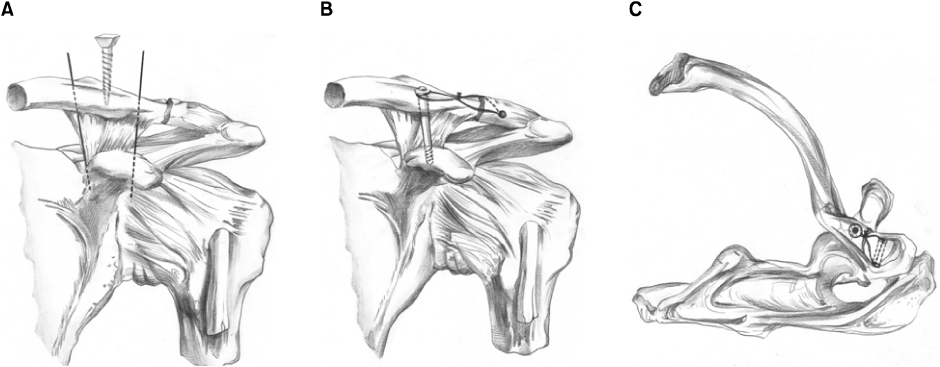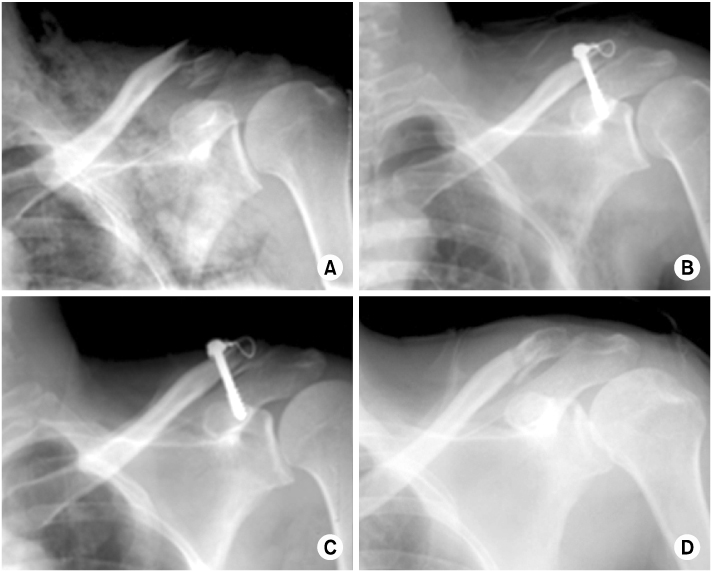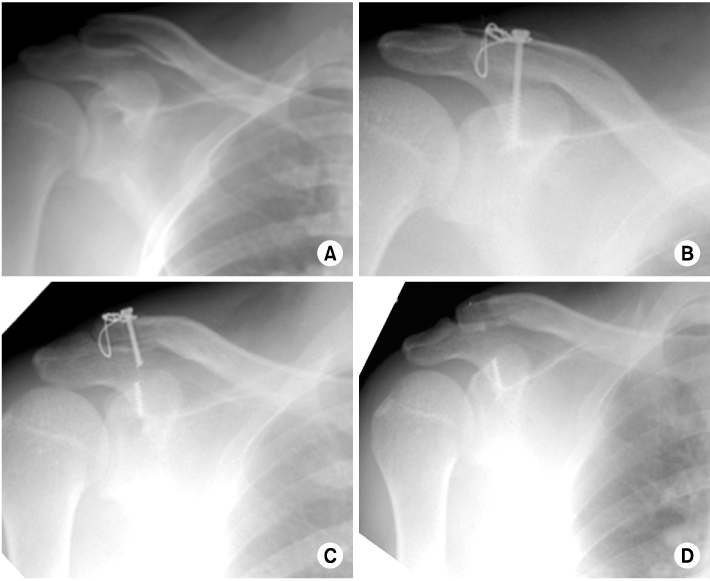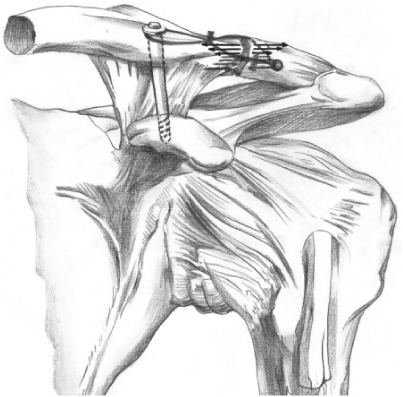J Korean Fract Soc.
2013 Jan;26(1):1-7. 10.12671/jkfs.2013.26.1.1.
Coracoclavicular Screw Fixation and Tension Band Wiring in Treatment of Distal Clavicle Fracture
- Affiliations
-
- 1Department of Orthopaedic Surgery, Inha University Hospital, Inha University School of Medicine, Incheon, Korea. TJLee@inha.ac.kr
- KMID: 1431709
- DOI: http://doi.org/10.12671/jkfs.2013.26.1.1
Abstract
- PURPOSE
The purpose of this study was to analyze the effectiveness of coracoclavicular screw fixation with tension band wiring in the treatment of displaced distal clavicle fractures.
MATERIALS AND METHODS
From October 2006 to December 2010, 18 patients with Neer type 2 displaced distal clavicle fracture were surgically treated. Fixation was performed, using coracoclavicular screw with tension band wiring. Radiographic and clinical evaluation was performed and the University of California at Los Angeles (UCLA) shoulder rating scale was employed for the assessment of shoulder joint function.
RESULTS
Osseous union was achieved approximately 9.5 weeks (8-11 weeks) in all patients. After the union, the screw and wire were removed under local anesthesia. All patients returned to the normal shoulder range of motion. Loosening of the screw was seen in two patients and breakage was seen in one patient. However, we could not observe the delayed union and complications, such as infection and refracture. All but one patient showed excellent results according to the UCLA shoulder score at one year after the operation.
CONCLUSION
Coracoclavicular screw fixation with tension band wiring in the treatment of displaced distal clavicle fractures is a clinically useful technique with good result and less complication.
Keyword
MeSH Terms
Figure
Reference
-
1. Ballmer FT, Gerber C. Coracoclavicular screw fixation for unstable fractures of the distal clavicle. A report of five cases. J Bone Joint Surg Br. 1991. 73:291–294.
Article2. Bezer M, Aydin N, Guven O. The treatment of distal clavicle fractures with coracoclavicular ligament disruption: a report of 10 cases. J Orthop Trauma. 2005. 19:524–528.
Article3. Brunner U, Habermeyer P, Schweiberer L. Special status of lateral clavicular fracture. Orthopade. 1992. 21:163–171.4. Fazal MA, Saksena J, Haddad FS. Temporary coracoclavicular screw fixation for displaced distal clavicle fractures. J Orthop Surg (Hong Kong). 2007. 15:9–11.
Article5. Harris RI, Wallace AL, Harper GD, Goldberg JA, Sonnabend DH, Walsh WR. Structural properties of the intact and the reconstructed coracoclavicular ligament complex. Am J Sports Med. 2000. 28:103–108.
Article6. Jin CZ, Kim HK, Min BH. Surgical treatment for distal clavicle fracture associated with coracoclavicular ligament rupture using a cannulated screw fixation technique. J Trauma. 2006. 60:1358–1361.
Article7. Kao FC, Chao EK, Chen CH, Yu SW, Chen CY, Yen CY. Treatment of distal clavicle fracture using Kirschner wires and tension-band wires. J Trauma. 2001. 51:522–525.
Article8. Kona J, Bosse MJ, Staeheli JW, Rosseau RL. Type II distal clavicle fractures: a retrospective review of surgical treatment. J Orthop Trauma. 1990. 4:115–120.9. Levy O. Simple, minimally invasive surgical technique for treatment of type 2 fractures of the distal clavicle. J Shoulder Elbow Surg. 2003. 12:24–28.
Article10. López JM, Torrens C, León V, Marín M. Unusual fracture of distal third of the clavicle in a hockey player: case report and a new approach to treatment. Knee Surg Sports Traumatol Arthrosc. 1999. 7:132–134.
Article11. Moneim MS, Balduini FC. Coracoid fracture as a complication of surgical treatment by coracoclavicular tape fixation. A case report. Clin Orthop Relat Res. 1982. (168):133–135.12. Murphy DF, Greene WB, Dameron TB Jr. Displaced olecranon fractures in adults. Clinical evaluation. Clin Orthop Relat Res. 1987. (224):215–223.
Article13. Neer CS 2nd. Fracture of the distal clavicle with detachment of the coracoclavicular ligaments in adults. J Trauma. 1963. 3:99–110.
Article14. Neer CS 2nd. Fractures of the distal third of the clavicle. Clin Orthop Relat Res. 1968. 58:43–50.15. Nordqvist A, Petersson C, Redlund-Johnell I. The natural course of lateral clavicle fracture. 15 (11-21) year follow-up of 110 cases. Acta Orthop Scand. 1993. 64:87–91.
Article16. Rijal L, Sagar G, Joshi A, Joshi KN. Modified tension band for displaced type 2 lateral end clavicle fractures. Int Orthop. 2012. 36:1417–1422.
Article17. Tambe AD, Motkur P, Qamar A, Drew S, Turner SM. Fractures of the distal third of the clavicle treated by hook plating. Int Orthop. 2006. 30:7–10.
Article18. Thomas PR, Richard EB, Christopher GM. AO principles of fracture management. 2007. 2nd ed. New York: Thieme;249–255.19. Tiren D, van Bemmel AJ, Swank DJ, van der Linden FM. Hook plate fixation of acute displaced lateral clavicle fractures: mid-term results and a brief literature overview. J Orthop Surg Res. 2012. 7:2.
Article20. Webber MC, Haines JF. The treatment of lateral clavicle fractures. Injury. 2000. 31:175–179.
Article
- Full Text Links
- Actions
-
Cited
- CITED
-
- Close
- Share
- Similar articles
-
- Treatment of Distal Clavicle Type II Fracture using K-Wires and Tension Band Wiring
- Operative Treatment of patellar Fractures
- Tension band wiring and Modified tension band wiring in the Operative Treatment of Patella Fracture
- Tension Band Wiring for Distal Clavicle Fracture: Radiologic Analysis and Clinical Outcome
- Tension Band Wiring with Anchoring Screw in Medial Malleolar Fracture





